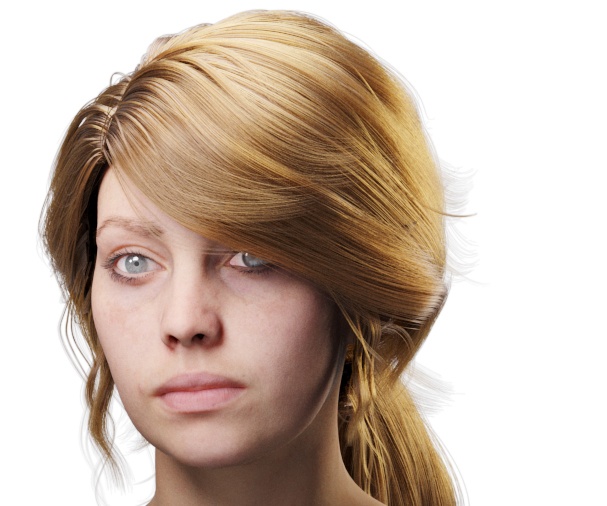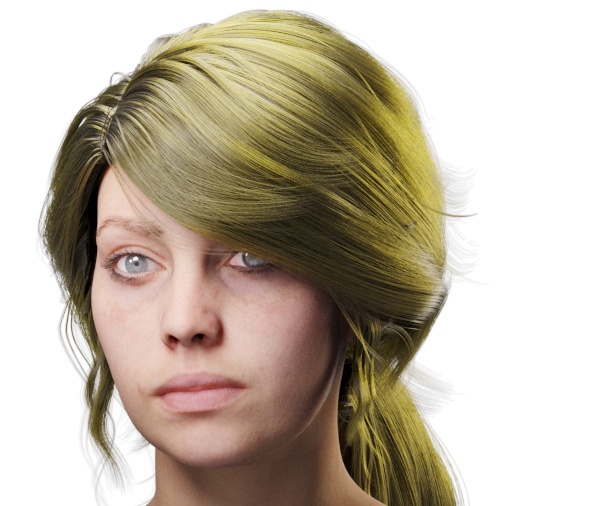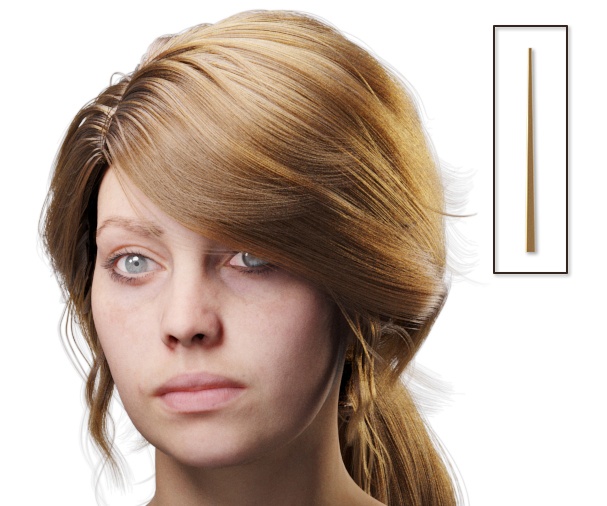This page provides information on the BRDFHair material node.
Page Contents
Overview
The V-Ray Hair material is specifically designed for rendering hair and fur and provides settings for a workflow based on the physiology of real hair. Instead of tweaking arbitrary colors that mix together, the new Hair Next material uses a simple melanin slider that determines the hair color just like in the real world. The material is the product of research based on the paper A Practical and Controllable Hair and Fur Model for Production Path Tracing.
UI Path: ||shop Network|| > V-Ray Material node > Material > Hair
Node
The BRDFHair node provides inputs for controlling various material properties. They correspond to parameters in the section below.
Main
Dye Color – Applies a color tint to the hair. For a dyed hair look, set the melanin to 0, otherwise the melanin will darken the dye color and pheomelanin will introduce redness to it. White means no hair dye. See the Dye color example below.
Melanin – The pigmentation component that gives the hair strand its main color. The higher the value assigned, the higher the concentration of melanin and the darker the hair strands are. See the Melanin example below to understand how different values work.
Pheomelanin – The redness (pheomelanin content) of the hair strand as fraction of all melanin. 1.0 makes the hair redder. The ratio of melanin to pheomelanin determines how red the hair is. The pheomelanin amount will have no effect if the melanin is set to 0. See the Pheomelanin example below.
Glossiness – Controls the glossiness along the hair strand. It primarily controls the width of the highlight, essentially how shiny the hair appears.
Primary Glossiness Boost – Additional scaling factor to boost the primary reflection glossiness. This can be useful for reproducing the effect of shiny coating on rough looking fur.
Softness – Controls the overall softness of the hair by how much the highlights are wrapped around the individual hair strands. Higher values make the highlights wrap almost completely around the strands giving the hair a smoother look, while lower values make it look crisper. See the Softness example below.
Highlight Shift– Shifts the highlights along the hair strand. Positive values shift the highlight away from the root of the hair, while negative values move the highlight closer to the root. Values in the range 2-4 are typical for human hair. See the Highlight shift example below.
IOR – Hair index of refraction. The typical value for human hair is 1.55. The higher the value, the more reflective the hair strands. See the IOR example below.
Trace Depth – The number of indirect bounces used to compute the effect of the multiple scattering. It can significantly affect the hair appearcne, epsecially for light colored hairs. The number of bounces necessary can vary from 5 for dark colored hairs, to 30 and more for light colored ones.
Subdivs – Controls the number of samples to use when defining the quality of the final rendering of the material. Lower values will render faster, but the result will be noisier. Higher values take longer but produce smoother results. This parameter is only available when Use local subdivs is enabled in the DMC Sampler settings.
Example: Melanin
The pigmentation component that gives the hair strand its main color. The higher the value assigned, the higher the concentration of melanin, the darker the hair strands are. In the example below, pheomelanin is set to 0.
Example: Pheomelanin
The redness (pheomelanin content) of the hair strand as fraction of all melanin. 1.0 makes the hair redder. The ratio of melanin to pheomelanin determines how red your hair is. The pheomelanin amount will have no effect if melanin is set to 0. In the example below, melanin is set to 0.4.
Example: Dye color
Applies a color tint to the hair. For a dyed hair look, set the melanin to 0, otherwise the melanin will darken the dye color and pheomelanin will introduce redness to it. White means no hair dye. In the example below, the Dye color is set to pink (H=0,S=250,V=104) and we the hue value is adjusted. Melanin is set to 0.4.
Example: Softness
Controls the overall softness of the hair by how much the highlights are wrapped around the individual hair strands. Higher values make the highlights wrap almost completely around the strands giving the hair a smoother look, while lower values make it look crisper. In the example below, the effect is also shown on a single hair strand. Melanin is set to 0.4.
Example: Highlight shift
Shifts the highlights along the hair strand. Positive values shift the highlight away from the root of the hair, while negative values move the highlight closer to the root. In the example below, melanin is set to 0.6.
Example: IOR
Hair index of refration. The typical value for human hair is 1.55. The higher the value, the more reflective the hair strands. In the example below, melanin is set to 0.6.
Random
The Randomization parameters can be used to introduce variation of the general parameter values. When using randomization, different hair strands will receive slightly different values for the below parameteres, so in fact the randomization works on a per strand basis.
Melanin – Adds variation to the amount of melanin in each hair strand.
HUE – Adds variation to the hue component of the dye color. This makes each strand appear with a different dye color. This parameter has no effect, when the dye color is not used, i.e. when the dye color is pure white.
Saturation – Randomizes the saturation of the dye color between hair strands. This makes each strand appear with a more or less saturated dye color. This parameter has no effect, when the dye color is not used, i.e. when the dye color is pure white.
Value – Adds variation to the value component of the dye color. This makes each strand appear with a brighter or darker dye color. This parameter has no effect, when the dye color is not used, i.e. when the dye color is pure white.
Tangent – Adds a random offset to the hair tangent. This makes the hair stands receive light from slightly different directions, which also means that the highlights will be placed in slightly different places for each strand. Note that this parameter is depends on the scene scale.
Roughness Length –
Roughness Width –
IOR – Randomizes the IOR value for each hair strand. This makes some strands more reflective, and others - less reflective.
Highlight Shift – Adds variation to the highlight shift for each strand. This offsets the highlights closer or further away from the root of the hair on a per strand basis.



























































